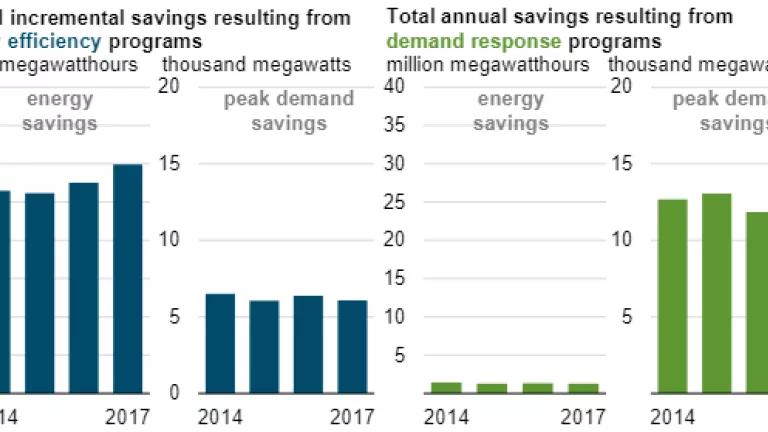Efficiency Saving Energy When We Need It Most – And Cheaply

A key energy trend, detailed in the Energy Information Administration’s (EIA) annual survey of electric utilities, is actually a longstanding one: energy efficiency continues to deliver energy and customer bill savings -- at low cost -- when we need it most.
Savings up – bills down
New (or incremental) savings from utility-run energy efficiency programs designed to help customers cut energy waste have gone up in recent years, even as costs have stayed nearly flat, according to a recent analysis from EIA. The results of EIA's survey confirm these programs are saving energy, which lowers electric bills for customers while boosting reliability on the grid.
As part of a larger look at utility demand-side management programs (programs that help customers save energy and money), EIA examined incremental energy savings (or first-year savings) from energy efficiency programs. These programs typically offer incentives that help homes and businesses upgrade to money-saving fixtures: rebates for energy-smart appliances and efficient light bulbs and free energy audits, for example.
The incremental savings from these types of programs increased nearly 13 percent, from 26.5 million megawatt hours in 2014 to 29.9 million megawatt hours in 2017, even as program spending stayed flat. The data comes from the agency's Annual Electric Power Industry Report, a survey of electric utilities.
Incremental energy savings in 2017, which are enough to power more than 2.8 million American homes for a year, punctuate how powerful energy efficiency can be in avoiding emissions from power plants. In fact, a separate analysis recently found that the electricity savings from energy efficiency programs in 2017 exceeded the annual production of eight giant coal-fired power plants. From California to Missouri to Virginia, states are seeing significant utility commitments to energy efficiency, because it's possible to extract meaningful savings from modest investments. And the recent plethora of utility commitments to ambitious clean energy and climate reduction goals are likely contributing as well.
Over the long term, utility energy efficiency efforts are remarkably cost-effective. Life cycle costs for every kilowatt hour saved from these programs amount to just 2 cents a year. "Most of the utility expenditures are one-time, up-front costs," EIA says, "but the energy savings they produce continue for many years, such as discounts for energy-efficient appliances or free energy-efficient lightbulbs."
Savings when we need them most
Saving energy during peak times (like a hot summer day) allows us to avoid building large, expensive power plants that are only needed for a few hours every year. And especially as renewable energy sources become a larger proportion of our energy supply, saving energy at peak times is even more valuable than saving just any kilowatt-hour. That is because more of our demand for energy is concentrated during just a few hours, and those hours don’t always coincide with when solar and wind are available. EIA evaluated the peak savings resulting from both energy efficiency and demand response programs, which for example, offer incentives to customers to allow the utility to cycle their air conditioner on and off to reduce electricity use during peak hours.
Demand response programs can be critical tools for regional transmission organizations such as the Electricity Reliability Council of Texas (ERCOT), which faces hot summers and low power reserves. They helped ERCOT shave about 3.7 percent off peak demand in 2017, EIA notes, helping stabilize the grid and preventing blackouts. But these savings from demand response programs are often very short lived. Energy efficiency programs don’t always get the credit they deserve for these peak savings, which are much longer lived since they often involve installation of an efficient device that produces those savings for years.
They are both critical tools, with much untapped and cost-effective potential that we should rely on much more heavily.
So, what gives, DOE?
EIA’s survey looked only at customer-funded programs, which increase consumer adoption of efficient products and measures and provide the basis for an even larger and cheaper efficiency resource – appliance and equipment efficiency standards. Long-established federal efficiency standards for appliances and equipment have saved consumers and businesses nearly $2 trillion on utility bills over the past three decades while creating jobs in every state.
With all of this value, it is ironic that the Trump administration is working to undermine the same commonsense policies that help deliver these benefits to utility customers, aiming to roll back or delay important energy efficiency standards.
Under Trump, the Department of Energy (DOE) is attempting to exclude light bulbs used in 2.7 billion U.S. sockets from the next stage of improved lighting efficiency standards, which would prevent consumers from enjoying $12 billion in utility bill savings—$100 per U.S. household—every year. The agency also has allowed other appliance standards to languish while proposing new, unnecessary hurdles that will stymie future energy efficiency efforts. If those proposed hurdles had been in effect over the last decade, we would have missed out on energy-saving improvements to at least 16 products, leaving homes and businesses with higher electric bills.
We can't afford to lose momentum on energy efficiency. Despite these encouraging results, and other recent numbers from EIA showing that generation from wind and solar is growing while coal-fired power is on the decline, greenhouse gas emissions from the U.S. power sector still increased 1.4 percent in 2018, driven by seasonal energy demand and economic growth. As EIA's report confirms, energy efficiency and demand response are exceptionally potent and affordable ways to mitigate planet-warming pollution while saving people money.
Help us stop the assault on common sense.




